HI5003 Economics for Business: Demand and Supply in Australia
VerifiedAdded on 2023/06/15
|8
|1605
|365
Report
AI Summary
This report provides an analysis of the demand and supply dynamics within the Australian housing market, referencing an article by Michael Janda. It examines the balance between housing supply and demand in Australia compared to countries like Great Britain, Spain, and Ireland, highlighting Australia's relatively stable situation. The report interprets the market conditions using economic concepts, suggesting that while Australia's housing market is comparatively stable, there's a slight overproduction of residential properties, particularly in the luxury sector. The report recommends focusing on building budget housing to address market distortions and monitoring the sector to prevent future problems, emphasizing the importance of balancing market power between supply and demand sides. Desklib offers a wealth of similar resources for students.
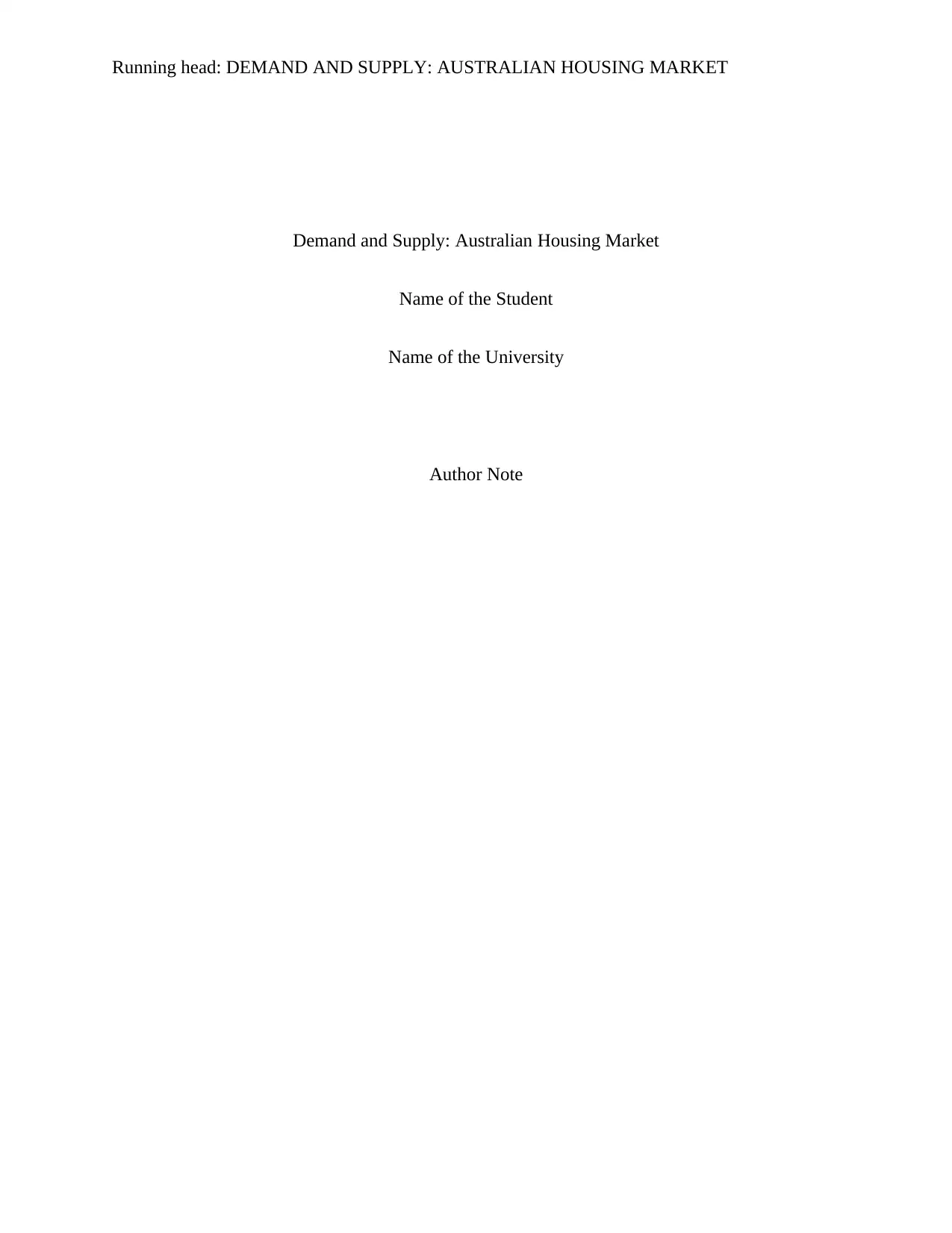
Running head: DEMAND AND SUPPLY: AUSTRALIAN HOUSING MARKET
Demand and Supply: Australian Housing Market
Name of the Student
Name of the University
Author Note
Demand and Supply: Australian Housing Market
Name of the Student
Name of the University
Author Note
Paraphrase This Document
Need a fresh take? Get an instant paraphrase of this document with our AI Paraphraser
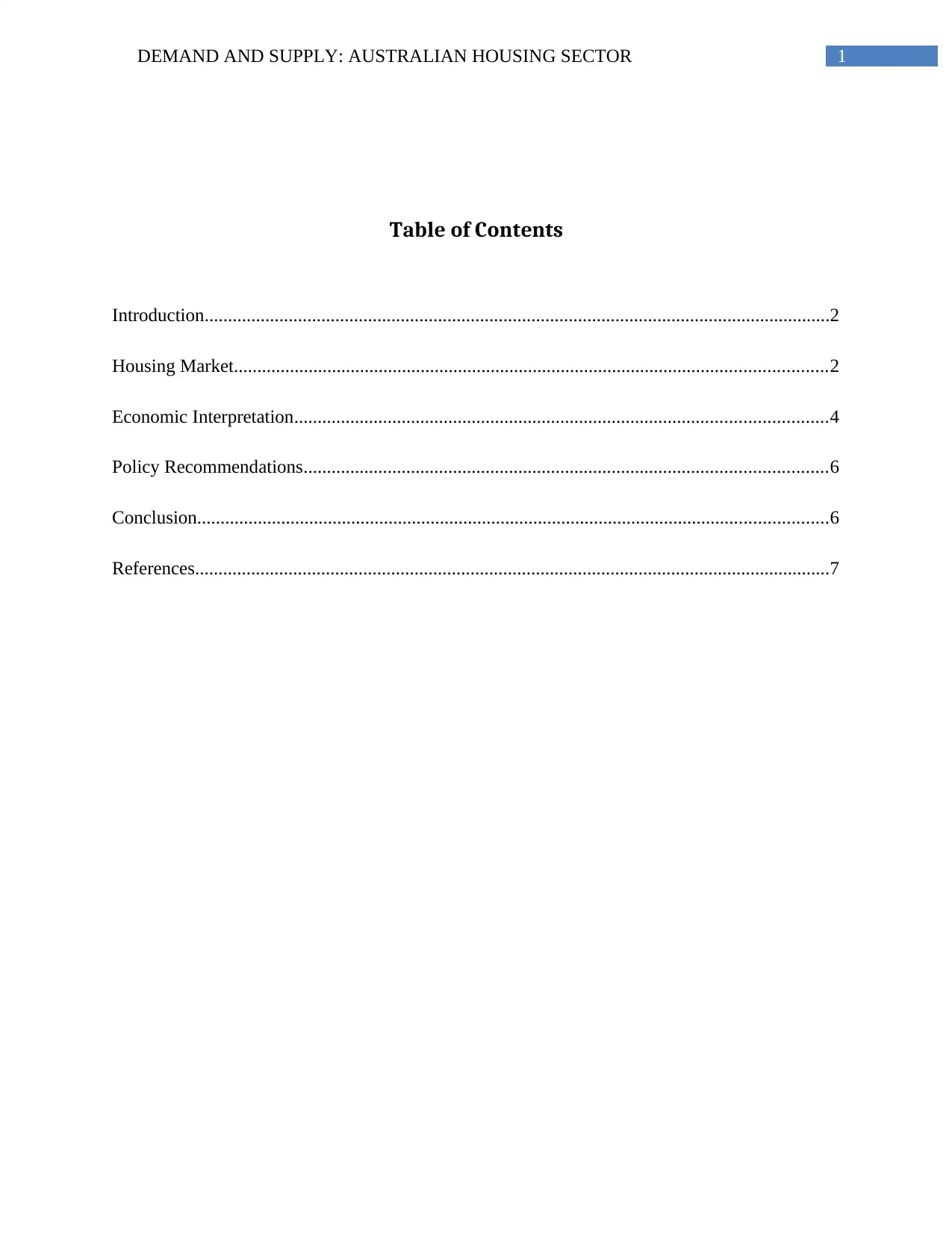
1DEMAND AND SUPPLY: AUSTRALIAN HOUSING SECTOR
Table of Contents
Introduction......................................................................................................................................2
Housing Market...............................................................................................................................2
Economic Interpretation..................................................................................................................4
Policy Recommendations................................................................................................................6
Conclusion.......................................................................................................................................6
References........................................................................................................................................7
Table of Contents
Introduction......................................................................................................................................2
Housing Market...............................................................................................................................2
Economic Interpretation..................................................................................................................4
Policy Recommendations................................................................................................................6
Conclusion.......................................................................................................................................6
References........................................................................................................................................7
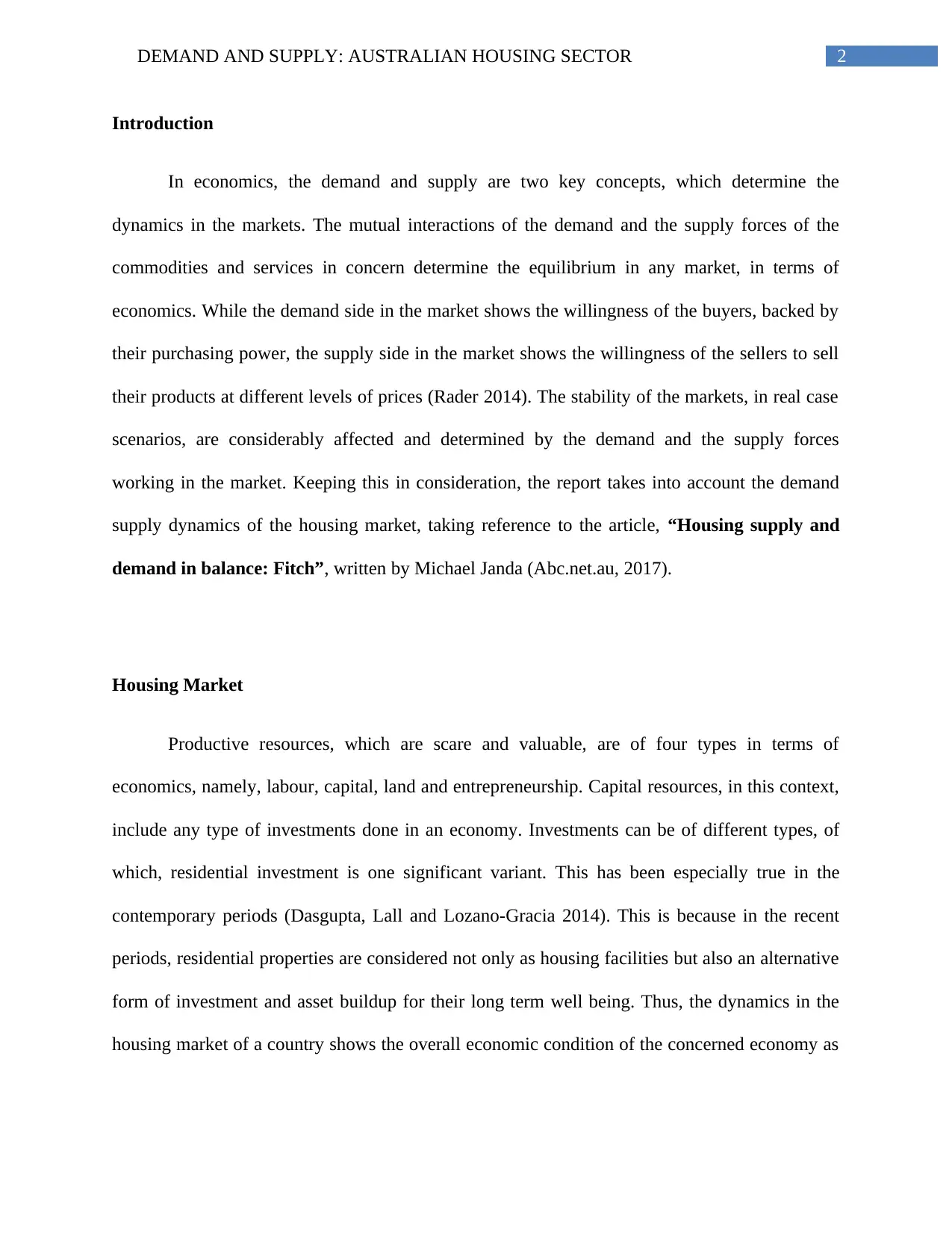
2DEMAND AND SUPPLY: AUSTRALIAN HOUSING SECTOR
Introduction
In economics, the demand and supply are two key concepts, which determine the
dynamics in the markets. The mutual interactions of the demand and the supply forces of the
commodities and services in concern determine the equilibrium in any market, in terms of
economics. While the demand side in the market shows the willingness of the buyers, backed by
their purchasing power, the supply side in the market shows the willingness of the sellers to sell
their products at different levels of prices (Rader 2014). The stability of the markets, in real case
scenarios, are considerably affected and determined by the demand and the supply forces
working in the market. Keeping this in consideration, the report takes into account the demand
supply dynamics of the housing market, taking reference to the article, “Housing supply and
demand in balance: Fitch”, written by Michael Janda (Abc.net.au, 2017).
Housing Market
Productive resources, which are scare and valuable, are of four types in terms of
economics, namely, labour, capital, land and entrepreneurship. Capital resources, in this context,
include any type of investments done in an economy. Investments can be of different types, of
which, residential investment is one significant variant. This has been especially true in the
contemporary periods (Dasgupta, Lall and Lozano-Gracia 2014). This is because in the recent
periods, residential properties are considered not only as housing facilities but also an alternative
form of investment and asset buildup for their long term well being. Thus, the dynamics in the
housing market of a country shows the overall economic condition of the concerned economy as
Introduction
In economics, the demand and supply are two key concepts, which determine the
dynamics in the markets. The mutual interactions of the demand and the supply forces of the
commodities and services in concern determine the equilibrium in any market, in terms of
economics. While the demand side in the market shows the willingness of the buyers, backed by
their purchasing power, the supply side in the market shows the willingness of the sellers to sell
their products at different levels of prices (Rader 2014). The stability of the markets, in real case
scenarios, are considerably affected and determined by the demand and the supply forces
working in the market. Keeping this in consideration, the report takes into account the demand
supply dynamics of the housing market, taking reference to the article, “Housing supply and
demand in balance: Fitch”, written by Michael Janda (Abc.net.au, 2017).
Housing Market
Productive resources, which are scare and valuable, are of four types in terms of
economics, namely, labour, capital, land and entrepreneurship. Capital resources, in this context,
include any type of investments done in an economy. Investments can be of different types, of
which, residential investment is one significant variant. This has been especially true in the
contemporary periods (Dasgupta, Lall and Lozano-Gracia 2014). This is because in the recent
periods, residential properties are considered not only as housing facilities but also an alternative
form of investment and asset buildup for their long term well being. Thus, the dynamics in the
housing market of a country shows the overall economic condition of the concerned economy as
⊘ This is a preview!⊘
Do you want full access?
Subscribe today to unlock all pages.

Trusted by 1+ million students worldwide
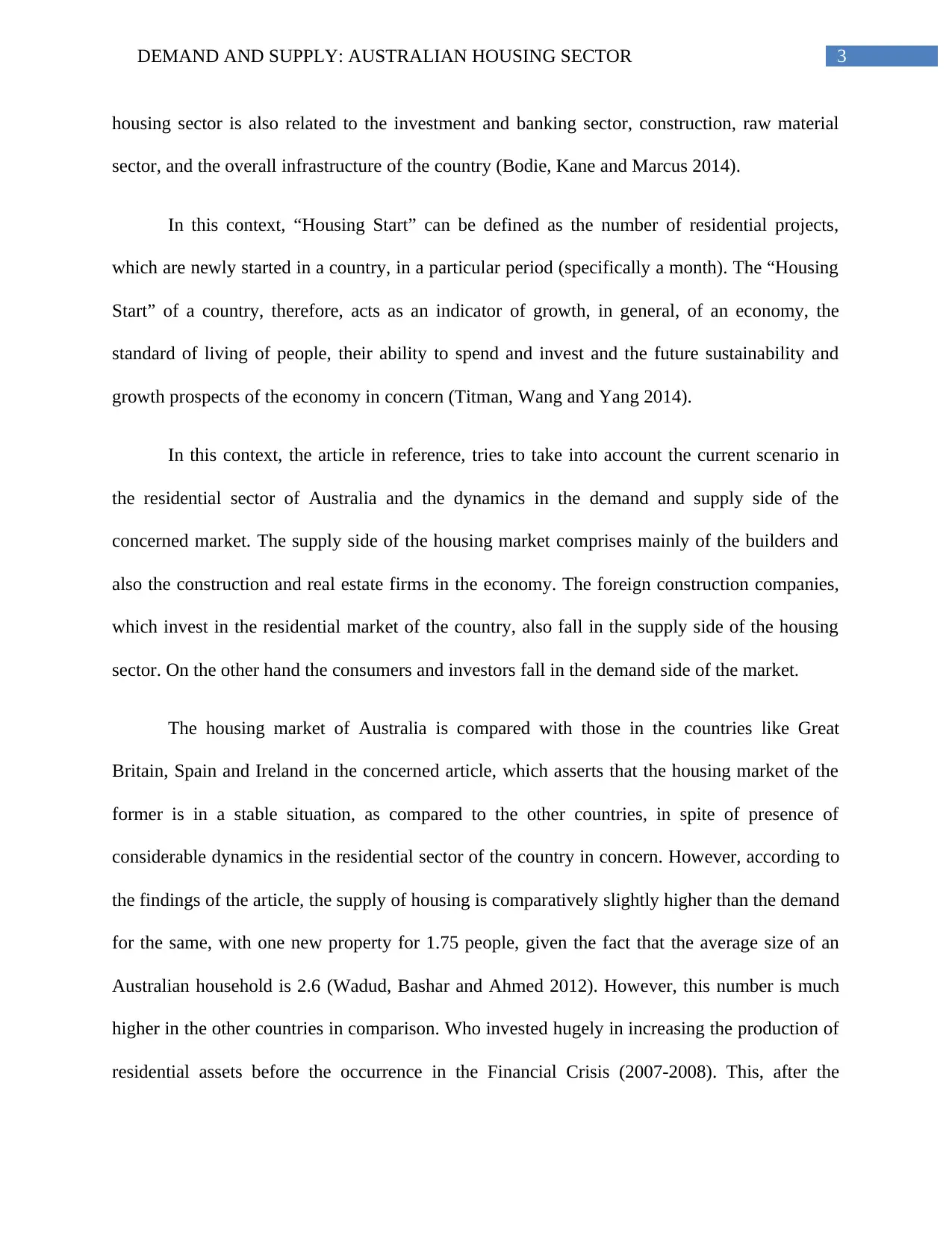
3DEMAND AND SUPPLY: AUSTRALIAN HOUSING SECTOR
housing sector is also related to the investment and banking sector, construction, raw material
sector, and the overall infrastructure of the country (Bodie, Kane and Marcus 2014).
In this context, “Housing Start” can be defined as the number of residential projects,
which are newly started in a country, in a particular period (specifically a month). The “Housing
Start” of a country, therefore, acts as an indicator of growth, in general, of an economy, the
standard of living of people, their ability to spend and invest and the future sustainability and
growth prospects of the economy in concern (Titman, Wang and Yang 2014).
In this context, the article in reference, tries to take into account the current scenario in
the residential sector of Australia and the dynamics in the demand and supply side of the
concerned market. The supply side of the housing market comprises mainly of the builders and
also the construction and real estate firms in the economy. The foreign construction companies,
which invest in the residential market of the country, also fall in the supply side of the housing
sector. On the other hand the consumers and investors fall in the demand side of the market.
The housing market of Australia is compared with those in the countries like Great
Britain, Spain and Ireland in the concerned article, which asserts that the housing market of the
former is in a stable situation, as compared to the other countries, in spite of presence of
considerable dynamics in the residential sector of the country in concern. However, according to
the findings of the article, the supply of housing is comparatively slightly higher than the demand
for the same, with one new property for 1.75 people, given the fact that the average size of an
Australian household is 2.6 (Wadud, Bashar and Ahmed 2012). However, this number is much
higher in the other countries in comparison. Who invested hugely in increasing the production of
residential assets before the occurrence in the Financial Crisis (2007-2008). This, after the
housing sector is also related to the investment and banking sector, construction, raw material
sector, and the overall infrastructure of the country (Bodie, Kane and Marcus 2014).
In this context, “Housing Start” can be defined as the number of residential projects,
which are newly started in a country, in a particular period (specifically a month). The “Housing
Start” of a country, therefore, acts as an indicator of growth, in general, of an economy, the
standard of living of people, their ability to spend and invest and the future sustainability and
growth prospects of the economy in concern (Titman, Wang and Yang 2014).
In this context, the article in reference, tries to take into account the current scenario in
the residential sector of Australia and the dynamics in the demand and supply side of the
concerned market. The supply side of the housing market comprises mainly of the builders and
also the construction and real estate firms in the economy. The foreign construction companies,
which invest in the residential market of the country, also fall in the supply side of the housing
sector. On the other hand the consumers and investors fall in the demand side of the market.
The housing market of Australia is compared with those in the countries like Great
Britain, Spain and Ireland in the concerned article, which asserts that the housing market of the
former is in a stable situation, as compared to the other countries, in spite of presence of
considerable dynamics in the residential sector of the country in concern. However, according to
the findings of the article, the supply of housing is comparatively slightly higher than the demand
for the same, with one new property for 1.75 people, given the fact that the average size of an
Australian household is 2.6 (Wadud, Bashar and Ahmed 2012). However, this number is much
higher in the other countries in comparison. Who invested hugely in increasing the production of
residential assets before the occurrence in the Financial Crisis (2007-2008). This, after the
Paraphrase This Document
Need a fresh take? Get an instant paraphrase of this document with our AI Paraphraser
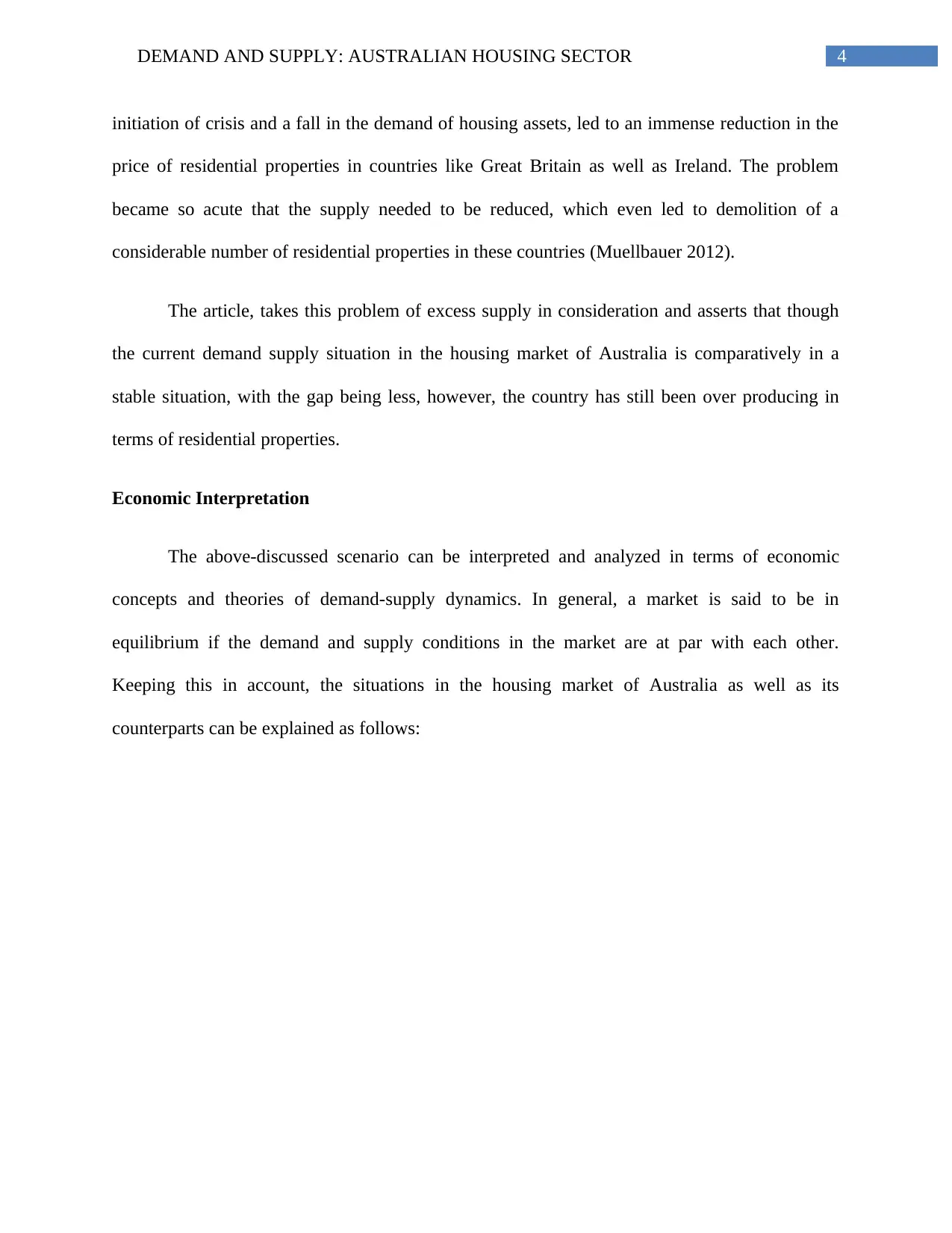
4DEMAND AND SUPPLY: AUSTRALIAN HOUSING SECTOR
initiation of crisis and a fall in the demand of housing assets, led to an immense reduction in the
price of residential properties in countries like Great Britain as well as Ireland. The problem
became so acute that the supply needed to be reduced, which even led to demolition of a
considerable number of residential properties in these countries (Muellbauer 2012).
The article, takes this problem of excess supply in consideration and asserts that though
the current demand supply situation in the housing market of Australia is comparatively in a
stable situation, with the gap being less, however, the country has still been over producing in
terms of residential properties.
Economic Interpretation
The above-discussed scenario can be interpreted and analyzed in terms of economic
concepts and theories of demand-supply dynamics. In general, a market is said to be in
equilibrium if the demand and supply conditions in the market are at par with each other.
Keeping this in account, the situations in the housing market of Australia as well as its
counterparts can be explained as follows:
initiation of crisis and a fall in the demand of housing assets, led to an immense reduction in the
price of residential properties in countries like Great Britain as well as Ireland. The problem
became so acute that the supply needed to be reduced, which even led to demolition of a
considerable number of residential properties in these countries (Muellbauer 2012).
The article, takes this problem of excess supply in consideration and asserts that though
the current demand supply situation in the housing market of Australia is comparatively in a
stable situation, with the gap being less, however, the country has still been over producing in
terms of residential properties.
Economic Interpretation
The above-discussed scenario can be interpreted and analyzed in terms of economic
concepts and theories of demand-supply dynamics. In general, a market is said to be in
equilibrium if the demand and supply conditions in the market are at par with each other.
Keeping this in account, the situations in the housing market of Australia as well as its
counterparts can be explained as follows:
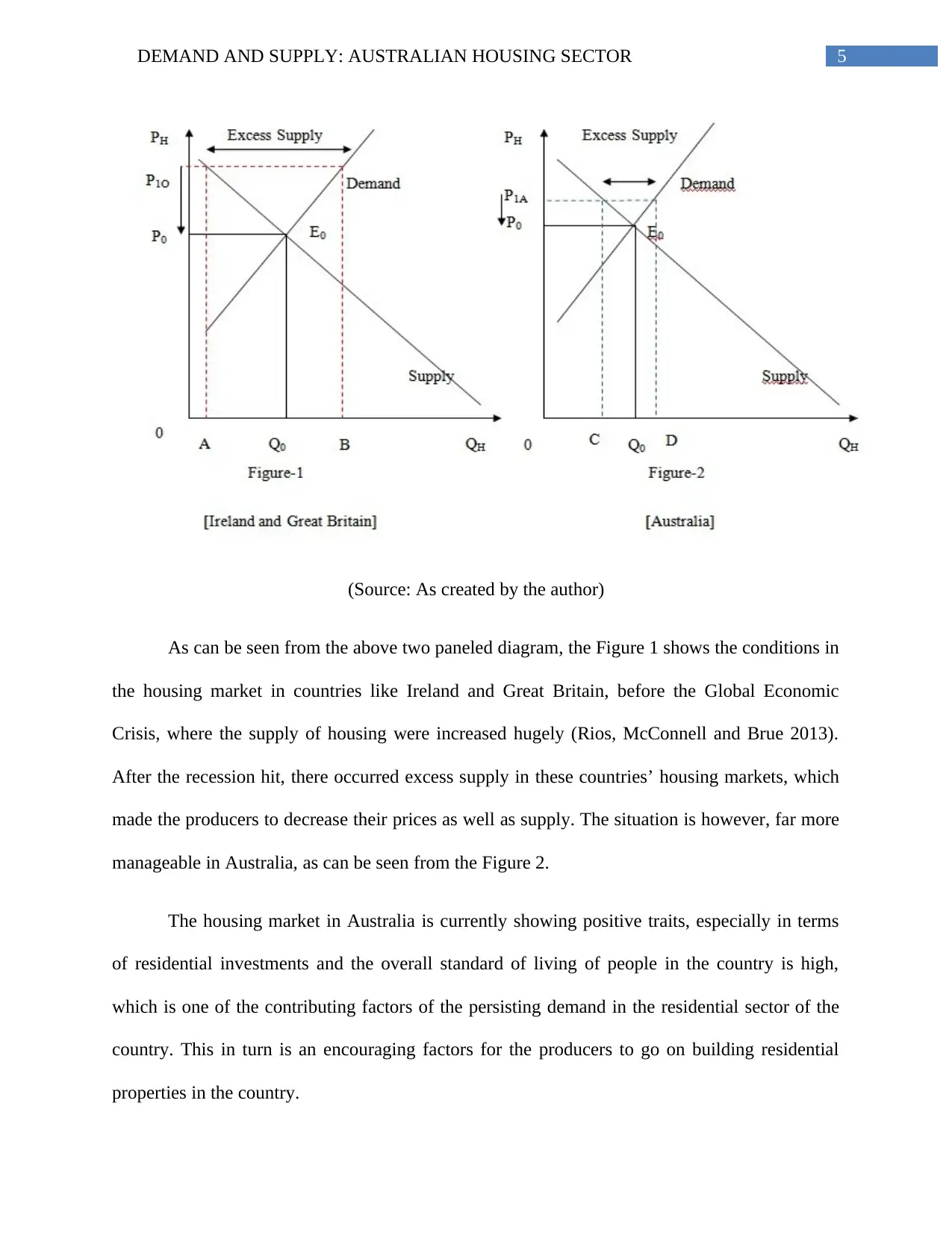
5DEMAND AND SUPPLY: AUSTRALIAN HOUSING SECTOR
(Source: As created by the author)
As can be seen from the above two paneled diagram, the Figure 1 shows the conditions in
the housing market in countries like Ireland and Great Britain, before the Global Economic
Crisis, where the supply of housing were increased hugely (Rios, McConnell and Brue 2013).
After the recession hit, there occurred excess supply in these countries’ housing markets, which
made the producers to decrease their prices as well as supply. The situation is however, far more
manageable in Australia, as can be seen from the Figure 2.
The housing market in Australia is currently showing positive traits, especially in terms
of residential investments and the overall standard of living of people in the country is high,
which is one of the contributing factors of the persisting demand in the residential sector of the
country. This in turn is an encouraging factors for the producers to go on building residential
properties in the country.
(Source: As created by the author)
As can be seen from the above two paneled diagram, the Figure 1 shows the conditions in
the housing market in countries like Ireland and Great Britain, before the Global Economic
Crisis, where the supply of housing were increased hugely (Rios, McConnell and Brue 2013).
After the recession hit, there occurred excess supply in these countries’ housing markets, which
made the producers to decrease their prices as well as supply. The situation is however, far more
manageable in Australia, as can be seen from the Figure 2.
The housing market in Australia is currently showing positive traits, especially in terms
of residential investments and the overall standard of living of people in the country is high,
which is one of the contributing factors of the persisting demand in the residential sector of the
country. This in turn is an encouraging factors for the producers to go on building residential
properties in the country.
⊘ This is a preview!⊘
Do you want full access?
Subscribe today to unlock all pages.

Trusted by 1+ million students worldwide
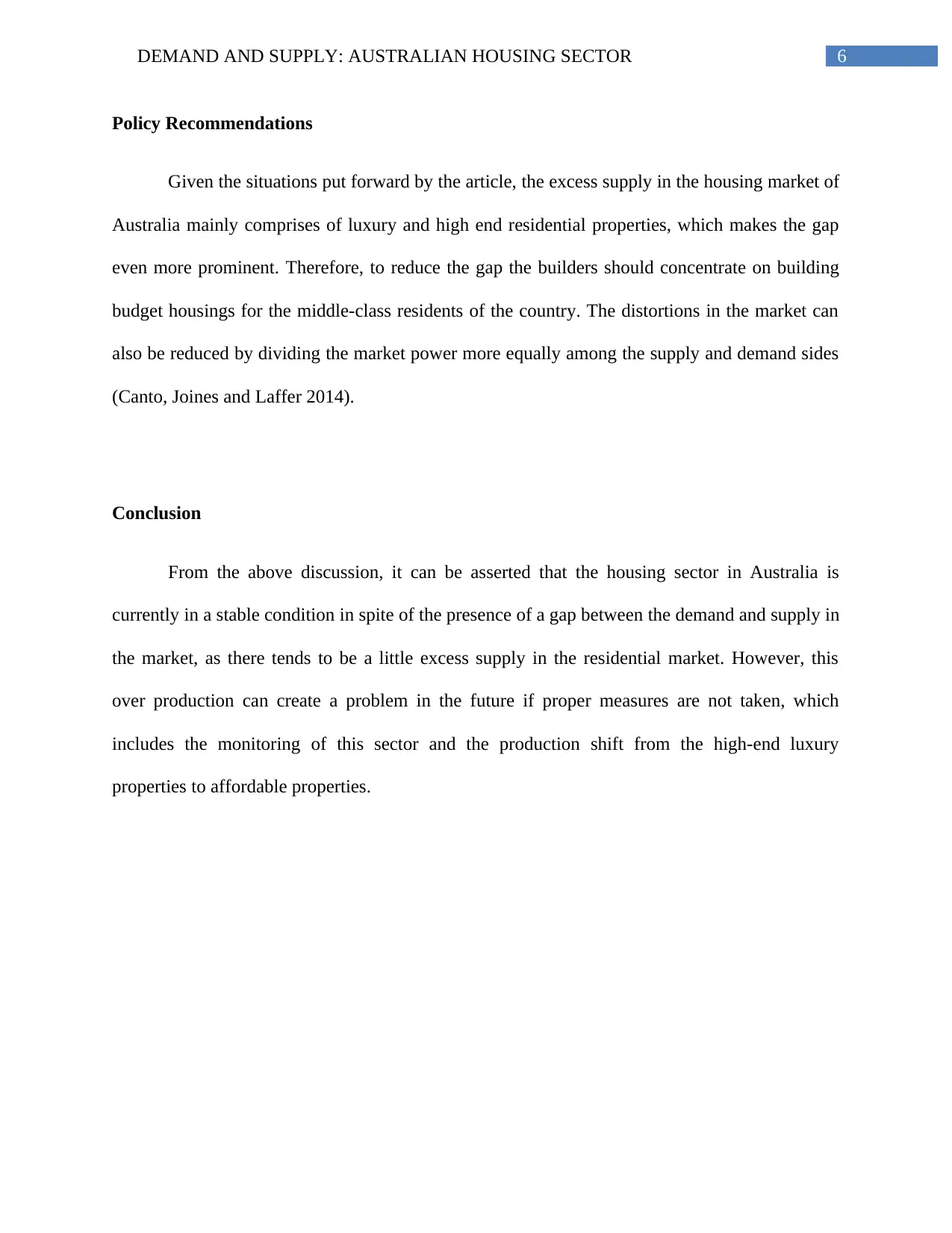
6DEMAND AND SUPPLY: AUSTRALIAN HOUSING SECTOR
Policy Recommendations
Given the situations put forward by the article, the excess supply in the housing market of
Australia mainly comprises of luxury and high end residential properties, which makes the gap
even more prominent. Therefore, to reduce the gap the builders should concentrate on building
budget housings for the middle-class residents of the country. The distortions in the market can
also be reduced by dividing the market power more equally among the supply and demand sides
(Canto, Joines and Laffer 2014).
Conclusion
From the above discussion, it can be asserted that the housing sector in Australia is
currently in a stable condition in spite of the presence of a gap between the demand and supply in
the market, as there tends to be a little excess supply in the residential market. However, this
over production can create a problem in the future if proper measures are not taken, which
includes the monitoring of this sector and the production shift from the high-end luxury
properties to affordable properties.
Policy Recommendations
Given the situations put forward by the article, the excess supply in the housing market of
Australia mainly comprises of luxury and high end residential properties, which makes the gap
even more prominent. Therefore, to reduce the gap the builders should concentrate on building
budget housings for the middle-class residents of the country. The distortions in the market can
also be reduced by dividing the market power more equally among the supply and demand sides
(Canto, Joines and Laffer 2014).
Conclusion
From the above discussion, it can be asserted that the housing sector in Australia is
currently in a stable condition in spite of the presence of a gap between the demand and supply in
the market, as there tends to be a little excess supply in the residential market. However, this
over production can create a problem in the future if proper measures are not taken, which
includes the monitoring of this sector and the production shift from the high-end luxury
properties to affordable properties.
Paraphrase This Document
Need a fresh take? Get an instant paraphrase of this document with our AI Paraphraser
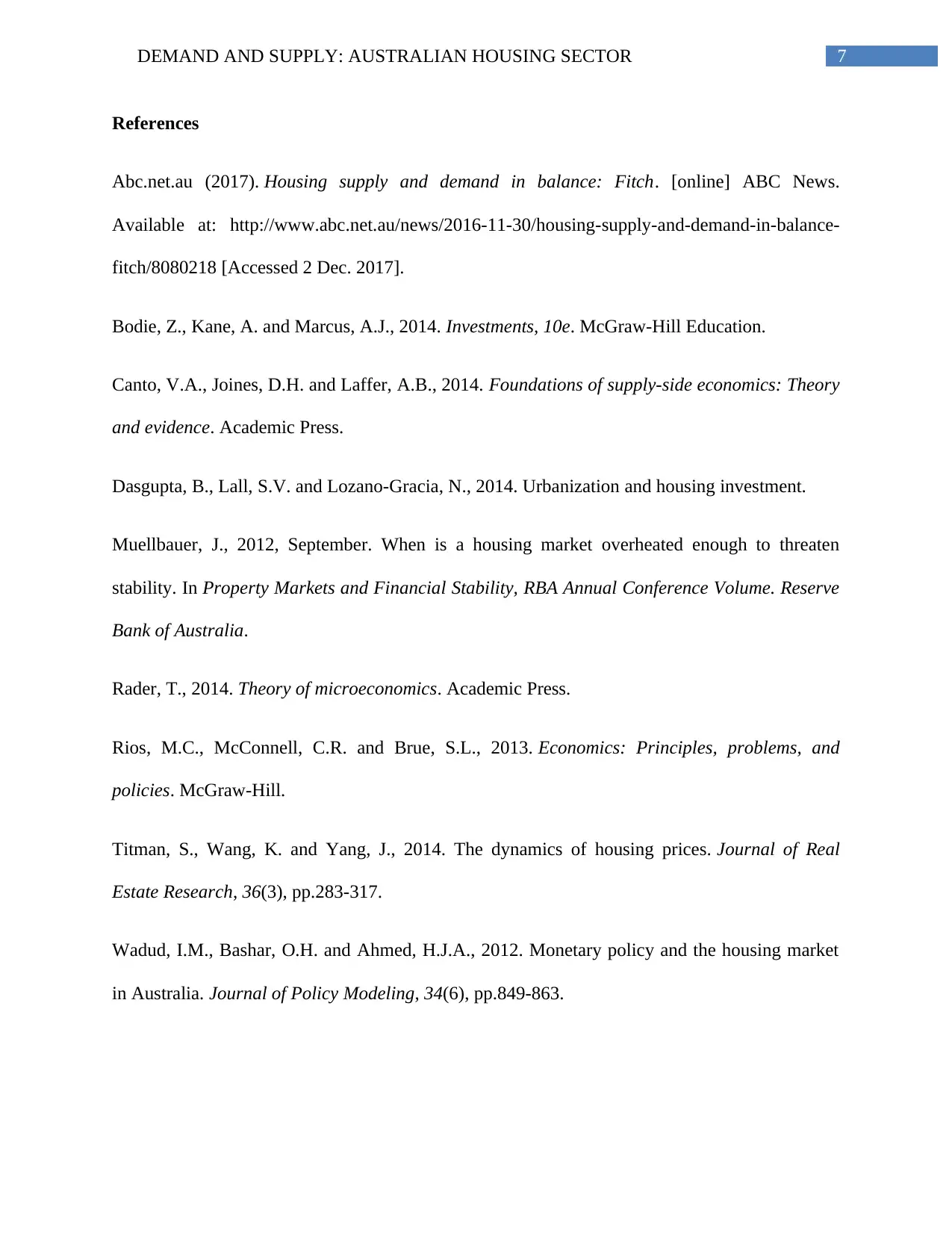
7DEMAND AND SUPPLY: AUSTRALIAN HOUSING SECTOR
References
Abc.net.au (2017). Housing supply and demand in balance: Fitch. [online] ABC News.
Available at: http://www.abc.net.au/news/2016-11-30/housing-supply-and-demand-in-balance-
fitch/8080218 [Accessed 2 Dec. 2017].
Bodie, Z., Kane, A. and Marcus, A.J., 2014. Investments, 10e. McGraw-Hill Education.
Canto, V.A., Joines, D.H. and Laffer, A.B., 2014. Foundations of supply-side economics: Theory
and evidence. Academic Press.
Dasgupta, B., Lall, S.V. and Lozano-Gracia, N., 2014. Urbanization and housing investment.
Muellbauer, J., 2012, September. When is a housing market overheated enough to threaten
stability. In Property Markets and Financial Stability, RBA Annual Conference Volume. Reserve
Bank of Australia.
Rader, T., 2014. Theory of microeconomics. Academic Press.
Rios, M.C., McConnell, C.R. and Brue, S.L., 2013. Economics: Principles, problems, and
policies. McGraw-Hill.
Titman, S., Wang, K. and Yang, J., 2014. The dynamics of housing prices. Journal of Real
Estate Research, 36(3), pp.283-317.
Wadud, I.M., Bashar, O.H. and Ahmed, H.J.A., 2012. Monetary policy and the housing market
in Australia. Journal of Policy Modeling, 34(6), pp.849-863.
References
Abc.net.au (2017). Housing supply and demand in balance: Fitch. [online] ABC News.
Available at: http://www.abc.net.au/news/2016-11-30/housing-supply-and-demand-in-balance-
fitch/8080218 [Accessed 2 Dec. 2017].
Bodie, Z., Kane, A. and Marcus, A.J., 2014. Investments, 10e. McGraw-Hill Education.
Canto, V.A., Joines, D.H. and Laffer, A.B., 2014. Foundations of supply-side economics: Theory
and evidence. Academic Press.
Dasgupta, B., Lall, S.V. and Lozano-Gracia, N., 2014. Urbanization and housing investment.
Muellbauer, J., 2012, September. When is a housing market overheated enough to threaten
stability. In Property Markets and Financial Stability, RBA Annual Conference Volume. Reserve
Bank of Australia.
Rader, T., 2014. Theory of microeconomics. Academic Press.
Rios, M.C., McConnell, C.R. and Brue, S.L., 2013. Economics: Principles, problems, and
policies. McGraw-Hill.
Titman, S., Wang, K. and Yang, J., 2014. The dynamics of housing prices. Journal of Real
Estate Research, 36(3), pp.283-317.
Wadud, I.M., Bashar, O.H. and Ahmed, H.J.A., 2012. Monetary policy and the housing market
in Australia. Journal of Policy Modeling, 34(6), pp.849-863.
1 out of 8
Related Documents
Your All-in-One AI-Powered Toolkit for Academic Success.
+13062052269
info@desklib.com
Available 24*7 on WhatsApp / Email
![[object Object]](/_next/static/media/star-bottom.7253800d.svg)
Unlock your academic potential
Copyright © 2020–2025 A2Z Services. All Rights Reserved. Developed and managed by ZUCOL.





